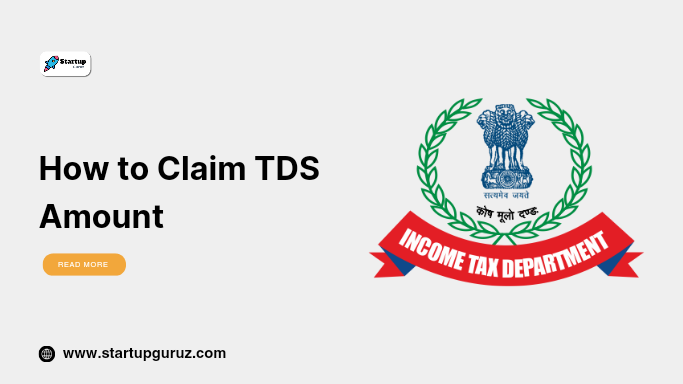How to Claim TDS Amount
How to Claim TDS Amount: A Comprehensive Guide
Tax Deducted at Source (TDS) is a method of tax collection by the Indian government, where the payer deducts tax from the payment made to the recipient and remits it to the government. Claiming the TDS amount is crucial to ensure that taxpayers do not pay more tax than they owe. This guide will help you understand the process of claiming TDS, the documents required, and the steps to follow for a successful claim.

Understanding TDS
TDS is deducted on various types of income such as salaries, interest payments by banks, rent payments, professional fees, and more. The deducted amount is deposited with the Income Tax Department and reflects in the recipient’s Form 26AS, which is a consolidated tax statement.
Importance of Claiming TDS
- Avoid Overpayment: Claiming TDS ensures that you do not overpay your taxes. The amount deducted at source should be adjusted against your total tax liability.
- Refund of Excess TDS: If the TDS deducted exceeds your actual tax liability, you can claim a refund.
- Compliance: Properly claiming TDS ensures you are in compliance with tax laws and regulations.
Steps to Claim TDS
1. Verify TDS Certificates
Ensure you have received all the TDS certificates (Form 16/16A) from deductors. These certificates contain details of the amount deducted and deposited to the government.
2. Check Form 26AS
Form 26AS is a consolidated tax statement available on the Income Tax Department’s website. It shows all the taxes deducted on your behalf. Ensure that the TDS entries in Form 26AS match the TDS certificates you have received.
3. Filing Income Tax Return (ITR)
To claim TDS, you need to file your Income Tax Return (ITR). Follow these steps:
- Gather Documents: Collect all necessary documents like TDS certificates, Form 26AS, income proofs, and investment proofs.
- Choose the Correct ITR Form: Select the appropriate ITR form based on your income sources.
- Fill in the Details: Enter your personal details, income details, and TDS details accurately.
- Claim Deductions: Claim all applicable deductions under sections like 80C, 80D, etc.
- Calculate Tax Liability: Compute your total tax liability and adjust the TDS deducted.
- Submit the ITR: File your ITR online on the Income Tax Department’s e-filing portal.
4. Verification of ITR
After filing the ITR, you need to verify it. This can be done through:
- E-Verification: Using methods like Aadhaar OTP, net banking, EVC through bank account, etc.
- Physical Verification: Sending a signed copy of ITR-V (acknowledgement) to CPC, Bangalore.
5. Processing of Refund
If the TDS deducted exceeds your actual tax liability, you can claim a refund. The Income Tax Department processes the refund and credits it to your bank account.
Common Mistakes to Avoid
- Incorrect Details: Ensure that the details entered in the ITR match the details in TDS certificates and Form 26AS.
- Missed Deductions: Claim all eligible deductions to reduce your tax liability.
- Non-Verification of ITR: Always verify your ITR to complete the filing process.
FAQs
1. What is TDS?
TDS stands for Tax Deducted at Source. It is a method of tax collection where the payer deducts tax from the payment made to the recipient.
2. Why is TDS deducted?
TDS is deducted to ensure that tax is collected at the source of income. It helps in minimizing tax evasion.
3. How can I check the TDS deducted on my income?
You can check the TDS deducted on your income by viewing your Form 26AS on the Income Tax Department’s e-filing portal.
4. What should I do if the TDS certificates do not match Form 26AS?
If there is a discrepancy between the TDS certificates and Form 26AS, contact the deductor and ask them to rectify the mistake.
5. Can I claim a refund if my TDS exceeds my tax liability?
Yes, if the TDS deducted exceeds your actual tax liability, you can claim a refund by filing your Income Tax Return (ITR).
6. How can I verify my ITR?
You can verify your ITR online through methods like Aadhaar OTP, net banking, or EVC through a bank account, or by sending a signed copy of ITR-V to CPC, Bangalore.
7. What happens if I do not verify my ITR?
If you do not verify your ITR, it will not be processed by the Income Tax Department, and you will not be able to claim your TDS refund.
8. How long does it take to get a TDS refund?
The processing time for a TDS refund can vary. It typically takes a few weeks to a few months, depending on the completeness and accuracy of your ITR and the verification process.
9. What is Form 16?
Form 16 is a TDS certificate issued by employers to employees. It contains details of the salary paid and the TDS deducted.
10. What is Form 16A?
Form 16A is a TDS certificate issued for TDS deducted on income other than salary, such as interest income, rent, professional fees, etc.
Conclusion
Claiming your TDS is an essential part of the tax filing process. By following the steps outlined in this guide, you can ensure that you correctly claim the TDS deducted on your income and receive any refunds due. Always keep your documents in order, verify the information in Form 26AS, and file your ITR accurately to avoid any issues. If you have any doubts or require assistance, consider consulting a tax professional.